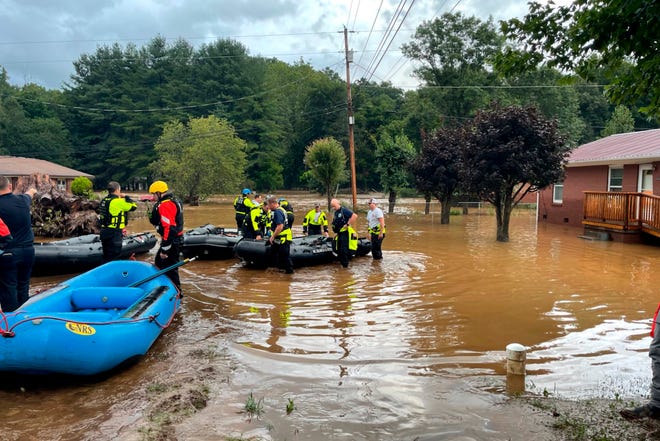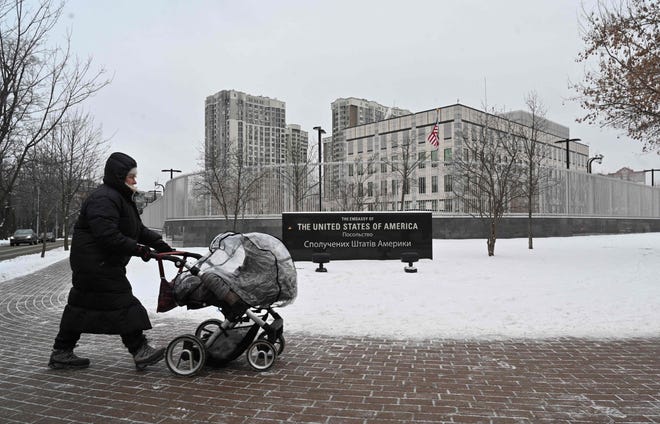
ASHEVILLE, N.C. – The remnants of Tropical Storm Fred soaked the Northeast on Thursday as Southern states assessed the damage from severe flooding, which in North Carolina had left two people dead and 20 missing.
Gov. Roy Cooper declared a state of emergency as western North Carolina saw intense flooding, with nearly 100 people rescued, after Fred drenched the state as a tropical depression earlier in the week.
Cooper planned to survey flood damage later Thursday afternoon. U.S. Sen. Thom Tillis toured the area earlier in the day.
The storm that blew through the area Tuesday made roads impassible, washed out bridges and swamped homes and businesses.
Meanwhile, the remnants of Fred were forecast to bring up to 5 inches of rain from New York State across New England on Thursday, according to the National Weather Service. Flash flood watches were in effect for much of New York, Vermont, New Hampshire and parts of Maine.
The weather service also warned a tornado was possible, and tornado warnings were issued across several New York and New England counties Thursday.
In North Carolina and West Virginia, power had largely been restored after about 37,000 customers were without electricity Wednesday, according to the utility tracker poweroutage.us. But about 17,000 customers in Pennsylvania and New York didn't have power as of Thursday afternoon, the tracker reported.
Monday and Tuesday marked the heaviest two-day rainfall in more than 50 years in Buncombe County, which includes Asheville, and neighboring Haywood County endured the worst of the storm, Cooper said in a news conference Wednesday.
More from North Carolina:Tropical Depression Fred prompts state of emergency, with 35 missing in Haywood County

As of Thursday morning, 20 people were unaccounted for in Haywood County, said Allison Richmond, the county's emergency services spokeswoman. The number of missing had been at 35 on Wednesday evening, but several people were determined to be safe and reunited with family, she said.
Richmond also confirmed the two fatalities and said officials were still working with the medical examiner on identifications.
Damage to roadways and bridges was significant, with at least 10 to 15 bridges damaged or destroyed, she said. About 200 search and rescue personnel were going home to home along the Pigeon River.
“We have homes that are completely destroyed and off their foundations,” Sheriff Greg Christopher said. “Mobile homes that were moved, and mobile home parks that I would call completely destroyed.”
Haywood County Board of Commissioners Chair Kevin Ensley said damage done to structures as a result of the storm totals about $300 million in the small Haywood unincorporated community of Cruso, which is considered the hardest hit by Fred. Ensley said 225 structures, including homes, were destroyed.
Ronnie Hannah, who has lived on Cruso Road for 74 years, had his chain-link fence ripped from the ground and his lawn destroyed in the storm.
"I’ve never seen anything this devastating,” Hannah said of the damage to the community. “I get depressed. I come out here and sit down and just think of what it looked like."
Jessica Vecchio, her two sons, two dogs and five cats slept in an SUV after their apartment was destroyed by flooding on Tuesday. “We we’re just putting stuff in bags that we could, trying to save what we could,” she said.
In Buncombe County, there were about 70 water rescues, and 911 call centers fielded double the typical volume of calls in a 24-hour period, spokesperson Lillian Govus said.
The storm caused rockslides and downed trees, including on the Blue Ridge Parkway.
The popular national park, which winds directly through Asheville, was almost completely closed in western North Carolina during the peak of the storm Tuesday, said spokesperson Leesa Brandon. Much has been cleared since, but the most of the main corridor through Asheville remained closed Wednesday, Brandon added.
Videos shared on social media also showed a river in the Pisgah National Forest with waters raging as river levels rose from the rainfall.
“What really caught us by surprise was how quickly the water rose, the tremendous amount and intensity of it,” said Zeb Smathers, mayor of the town of Canton, where water rescues also were needed.
Hurricane and COVID-19:Here's what you need to protect yourself.
Fred has been blamed for at least one other death after a driver hydroplaned and flipped into a ditch near Panama City, Florida.
The storm roared ashore Monday near Cape San Blas in the Florida Panhandle as a tropical storm. Fred flooded streets, knocked down power lines and trees and destroyed houses, mobile homes and other buildings across the South during its march north.
The storm caused more than a dozen tornadoes in Georgia and the Carolinas, according to the National Weather Service.
Two other storms, Tropical Storm Grace and Tropical Storm Henri, were active in the Atlantic Basin on Thursday. Grace made landfall in Mexico as a hurricane on Thursday, and Henri could be a threat to the Northeast and New England early next week.
Contributing: Karen Chávez, Asheville Citizen Times; Doyle Rice, USA TODAY; The Associated Press








